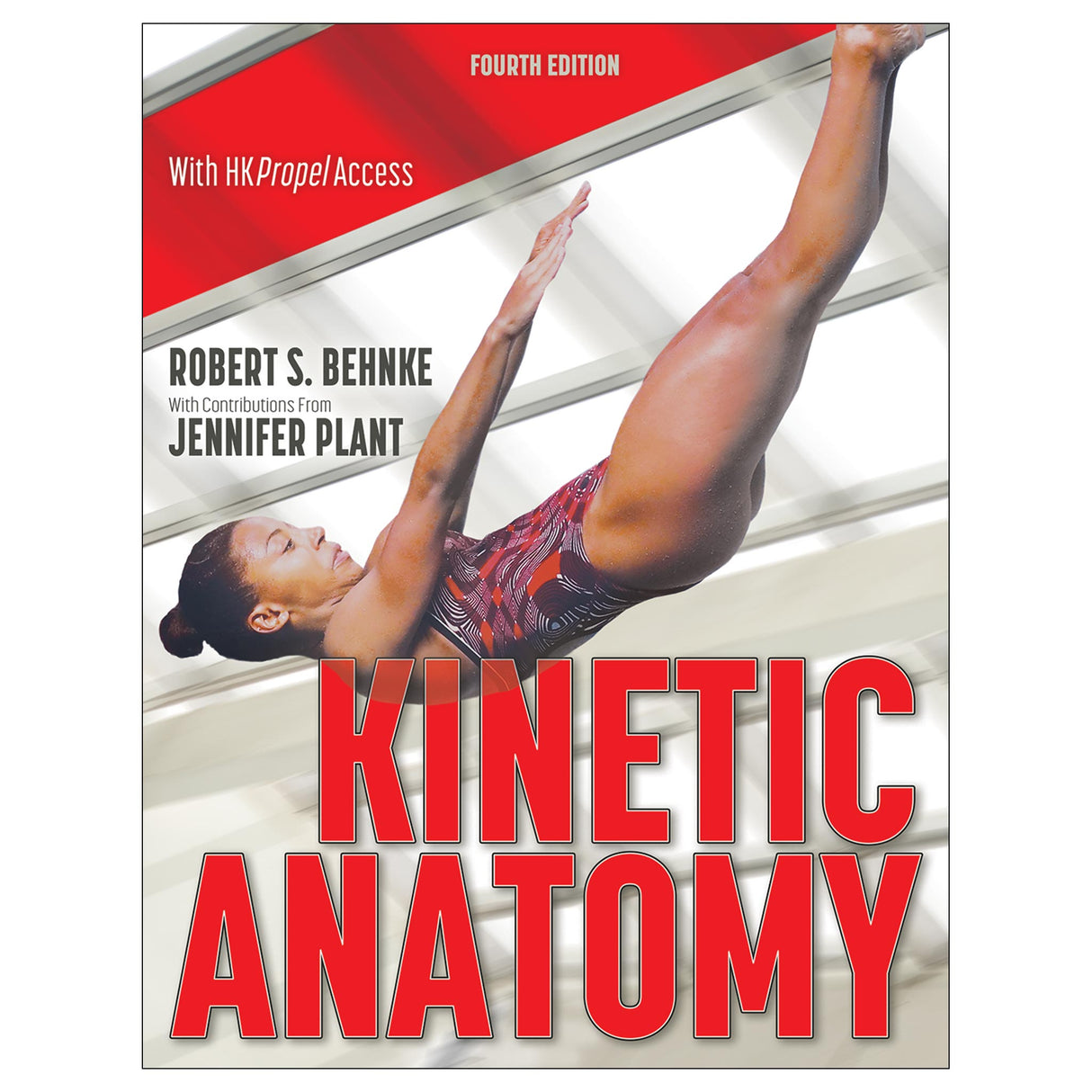Kinetic Anatomy 4th Edition Ebook With HKPropel Access
Author: Robert S. Behnke, Jennifer Plant
$125.95 CAD

Part I of the text introduces the basics of structural anatomy. It describes how bones, joints, muscles, nerves, and other essential anatomy work together to allow for fundamental movement. Part II details the anatomy of the upper extremity region, including the shoulder, elbow, forearm, wrist, and hand. Part III of the text explores the anatomy of the head, spinal column, thorax, and pelvis. These chapters include unique coverage not found in other anatomy texts, explaining how the brain, heart, and lungs—as the power centers of the nervous, cardiovascular, and respiratory systems—affect movement. Part IV discusses the anatomy of the lower extremity region: the hip, thigh, knee, lower leg, ankle, and foot. Parts II, III, and IV each end with a summary table that offers a quick reference for the components of the body region featured in that part.
Kinetic Anatomy, Fourth Edition, contains nearly 400 photos, illustrations, and infographics to help readers visualize structural anatomy and engage with their coursework. Throughout the book, Hands On exercises instruct readers to physically identify anatomical structures on themselves or on a partner, and Focus On sidebars illustrate circumstances in everyday activity that relate to the specific anatomical structures in the text. Pop quizzes provide readers an opportunity to strengthen their clinical reasoning skills by asking them to identify the muscles shown in the accompanying photo. The fourth edition is further enhanced with the addition of new online learning tools —all of which can be assigned, and progress tracked, by instructors directly through HKPropel:
- Anatomy labeling and coloring sheets offer students nearly 100 interactive activities that test their knowledge of anatomical structures and function.
- Learning activities; true-false, multiple-choice, and fill-in-the-blank questions; and functional movement exercises ensure students have a firm grasp of key points from each chapter.
- Chapter quizzes (assessments) may also be assigned; these are automatically graded to test comprehension of critical concepts.
Earn continuing education credits/units! A continuing education course and exam that uses this book is also available. It may be purchased separately or as part of a package that includes all the course materials and exam.
Note: A code for accessing HKPropel is included with this ebook.
Audience
Text for undergraduate students taking an introductory course in structural anatomy, including those studying exercise science, kinesiology, sports medicine, or physical education. Also a textbook for secondary school students studying human anatomy and a reference for professionals requiring knowledge of anatomy pertaining to human movement.Chapter 1. Structures
Bones
Joints
Muscles
Levers
Nerves
Blood Vessels
Other Tissues
Motor Unit
Chapter 2. Movement
Anatomical Locations
Planes and Axes
Fundamental Movements
Kinetic Chain
Part II. Upper Extremity
Chapter 3. The Shoulder
Bones of the Shoulder Girdle
Bones of the Shoulder Joint
Joints and Ligaments of the Shoulder Girdle
Ligaments of the Shoulder Joint
Other Ligaments of the Shoulder
Fundamental Movements and Muscles of the Shoulder Girdle
Fundamental Movements and Muscles of the Shoulder Joint
Combined Actions of the Shoulder Girdle and Shoulder Joint
Chapter 4. The Elbow and Forearm
Bones of the Elbow and Forearm
Joints and Ligaments of the Elbow and Forearm
Fundamental Movements and Muscles of the Elbow and Forearm
Chapter 5. The Wrist and Hand
Bones of the Wrist and Hand
Joints and Ligaments of the Wrist and Hand
Fundamental Movements of the Wrist and Hand
Extrinsic Muscles of the Wrist and Hand
Intrinsic Muscles of the Hand
Muscles of the Thumb
Chapter 6. Nerves and Blood Vessels of the Upper Extremity
Nerves of the Brachial Plexus
Major Arteries of the Upper Extremity
Major Veins of the Upper Extremity
Part II Summary Tables
Articulations of the Upper Extremity
Muscles, Nerves, and Blood Supply of the Upper Extremity
Part III. The Head, Spinal Column, Thorax, and Pelvis
Chapter 7. The Head
Bones of the Head
Joints of the Head
Ligaments of the Head
Sinuses
Fundamental Movements and Muscles of the Head
Chapter 8. The Spinal Column and Pelvis
Bones of the Spinal Column
Ligaments of the Spinal Column
Fundamental Movements and Muscles of the Spinal Column
Bones of the Pelvis
Ligaments of the Pelvis
Fundamental Movements and Muscles of the Pelvis
Chapter 9. The Thorax
Bones of the Thorax
Joints and Ligaments of the Thorax
Fundamental Movements and Muscles of the Thorax
Structures Within the Thorax
Chapter 10. Nerves and Blood Vessels of the Head, Spinal Column, Thorax, Heart, and Lungs
The Brain
Peripheral Nervous System
Arteries of the Head and Brain
Veins of the Head and Brain
Nerves of the Thorax and Trunk
Arteries of the Thorax and Trunk
Veins of the Thorax and Trunk
Nerves, Arteries, and Veins of the Heart and Lungs
Part III Summary Tables
Articulations of the Head, Spinal Column, Thorax, and Pelvis
Muscles, Nerves, and Blood Supply of the Head, Thorax, and Spinal Column
Part IV. Lower Extremity
Chapter 11. The Hip and Thigh
Bones of the Hip Joint and Thigh
Ligaments of the Hip Joint
Fundamental Movements of the Hip Joint
Muscles of the Hip Joint and Upper Leg (Thigh)
Chapter 12. The Knee
Bones of the Knee
Ligaments of the Knee
Menisci of the Knee
Fundamental Movements of the Knee and Lower Leg
Muscles of the Knee and Lower Leg
Chapter 13. The Lower Leg, Ankle, and Foot
Bones of the Lower Leg
Bones of the Foot
Joints and Ligaments of the Ankle and Foot
Fundamental Movements of the Lower Leg, Ankle, and Foot
Muscles of the Lower Leg, Ankle, and Foot
Chapter 14. Nerves and Blood Vessels of the Lower Extremity
Nerves of the Lumbosacral Plexus
Major Arteries of the Lower Extremity
Major Veins of the Lower Extremity
Part IV Summary Tables
Articulations of the Lower Extremity
Muscles, Nerves, and Blood Supply of the Lower Extremity
Nerves of the brachial plexus
Nerves, arteries, and veins of the heart and lungs




All ancillaries are free to adopting instructors through HKPropel.
Instructor guide. Includes chapter overviews, chapter objectives, lecture outlines, and ideas for lecture aids. A suggested course outline and a syllabus show instructors how to cover the text’s material in a semester.
Test package. Includes more than 600 questions in multiple-choice, true-false, and fill-in-the-blank formats.
Chapter quizzes. Contains ready-made quizzes (9 to 10 questions each) to assess student comprehension of the most important concepts in each chapter. Quizzes are compatible with learning management systems.
Presentation package. Features more than 200 PowerPoint slides of text and artwork from the book that can be used for class discussion and presentation. The slides in the presentation package can be used directly within PowerPoint or printed to make handouts for students. Instructors can easily add, modify, and rearrange the order of the slides.
Image bank. Includes most of the figures, photos, and tables from the text, sorted by chapter. These can be used in developing a customized presentation based on specific course requirements.
Instructors also receive access to all student materials in HKPropel. For Kinetic Anatomy, Fourth Edition, this includes multiple-choice and fill-in-the-blank questions and functional movement exercises. Also included are nearly 100 interactive or downloadable anatomy labeling and coloring sheets to help students test their knowledge of anatomical structures and function.





